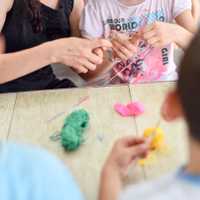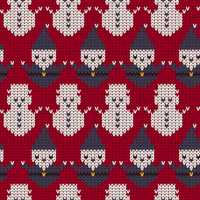New Advanced Techniques and Stitches When Home Crocheting
new advanced techniques and stitches when home crocheting
New Advanced Techniques and Stitches When Home Crocheting
by Loretta Crowder
New Advanced Techniques and Stitches When Home Crocheting
by Loretta Crowder
Don't let the name of the Tunisian Knit Stitch fool you. The Tunisian knit stitch isn't actually knitted; it's a crochet stitch. The only reason that we call it the knit stitch is because it looks like a stockinette stitch in knitting. This stitch is handy to know if you'd like your crochet work to resemble knitting.
First of all, crochet a starting chain of any length greater than 2 stitches. You can work either the front side or the back side of your starting chain.
Now, insert your hook into the second chain from your hook and pull up a loop. You must leave this loop on your crochet hook for the present time. Insert your hook into the next chain stitch and pull up another loop. Keep pulling up loops until you have one loop on your hook corresponding to each chain stitch in your starting chain.
Do not turn your work; keep the front of the work facing you - this is rather important to note at this time.
Rows like this where you are drawing up loops can also be called the forward or the forward pass. They can be called almost anything, however, to continue with the Tunisian knit stitch, work a chain stitch by looping the yarn over your hook and pulling it through the last loop on your hook.
Now, you yarn over and pull it through two loops.
Keep looping it over the hook and pulling the yarn the loops on your hook all the way across the row until only one loop remains on your hook. The remaining loop on the hook will count as the first stitch in the next row.
At this point in your crocheting, you must know if you are working the Tunisian simple stitch, and if you are, the next step would be to work the stitches into the vertical bars all the way across the next row.
Please note that there's a vertical bar below your active loop, but you can't really do anything with that one, so just ignore it and use the next closest vertical bar as your reference point. Using your crochet hook, you're going to pierce the fabric completely through from the front to the back, and the spot to do it is directly to the right of the vertical bar.
After you've pushed your hook through the fabric, yarn over and pull up a loop. Try to make sure that your hook went in at the correct spot visually. Continue pulling up loops in this manner all the way across the row.
Keep repeating the above process and you will find that you have mastered the Tunisian knit stitch.
This stitch is especially helpful when you are home crocheting dish cloths or face cloths - in fact, anything along those lines benefit from this stitch! For that matter, this stitch would be wonderful in a baby afghan.
If you don't already know how to make the Tunisian knit stitch, are you willing to learn how to make this awesome stitch for future use in your home crocheted projects?
There is a wealth of information to be found at http://learningeasycrochet.com.
Not only is there information, but it supplies encouragement as well.
When you get stuck, as we all do sometimes, leave a question in the comment box and you will get an answer within 24 hours.
When you sign up for a membership, you will receive a crochet pattern of your choice along with the help you may need to complete that project!
In the members area, you will shown "how to" and much more along with tips and tricks to speed up your progress.
Check it out today!
Article Source: http://EzineArticles.com/?expert=Loretta_Crowder http://EzineArticles.com/7172315
Don't let the name of the Tunisian Knit Stitch fool you. The Tunisian knit stitch isn't actually knitted; it's a crochet stitch. The only reason that we call it the knit stitch is because it looks like a stockinette stitch in knitting. This stitch is handy to know if you'd like your crochet work to resemble knitting.
First of all, crochet a starting chain of any length greater than 2 stitches. You can work either the front side or the back side of your starting chain.
Now, insert your hook into the second chain from your hook and pull up a loop. You must leave this loop on your crochet hook for the present time. Insert your hook into the next chain stitch and pull up another loop. Keep pulling up loops until you have one loop on your hook corresponding to each chain stitch in your starting chain.
Do not turn your work; keep the front of the work facing you - this is rather important to note at this time.
Rows like this where you are drawing up loops can also be called the forward or the forward pass. They can be called almost anything, however, to continue with the Tunisian knit stitch, work a chain stitch by looping the yarn over your hook and pulling it through the last loop on your hook.
Now, you yarn over and pull it through two loops.
Keep looping it over the hook and pulling the yarn the loops on your hook all the way across the row until only one loop remains on your hook. The remaining loop on the hook will count as the first stitch in the next row.
At this point in your crocheting, you must know if you are working the Tunisian simple stitch, and if you are, the next step would be to work the stitches into the vertical bars all the way across the next row.
Please note that there's a vertical bar below your active loop, but you can't really do anything with that one, so just ignore it and use the next closest vertical bar as your reference point. Using your crochet hook, you're going to pierce the fabric completely through from the front to the back, and the spot to do it is directly to the right of the vertical bar.
After you've pushed your hook through the fabric, yarn over and pull up a loop. Try to make sure that your hook went in at the correct spot visually. Continue pulling up loops in this manner all the way across the row.
Keep repeating the above process and you will find that you have mastered the Tunisian knit stitch.
This stitch is especially helpful when you are home crocheting dish cloths or face cloths - in fact, anything along those lines benefit from this stitch! For that matter, this stitch would be wonderful in a baby afghan.
If you don't already know how to make the Tunisian knit stitch, are you willing to learn how to make this awesome stitch for future use in your home crocheted projects?
There is a wealth of information to be found at http://learningeasycrochet.com.
Not only is there information, but it supplies encouragement as well.
When you get stuck, as we all do sometimes, leave a question in the comment box and you will get an answer within 24 hours.
When you sign up for a membership, you will receive a crochet pattern of your choice along with the help you may need to complete that project!
In the members area, you will shown "how to" and much more along with tips and tricks to speed up your progress.
Check it out today!
Article Source: http://EzineArticles.com/?expert=Loretta_Crowder http://EzineArticles.com/7172315




